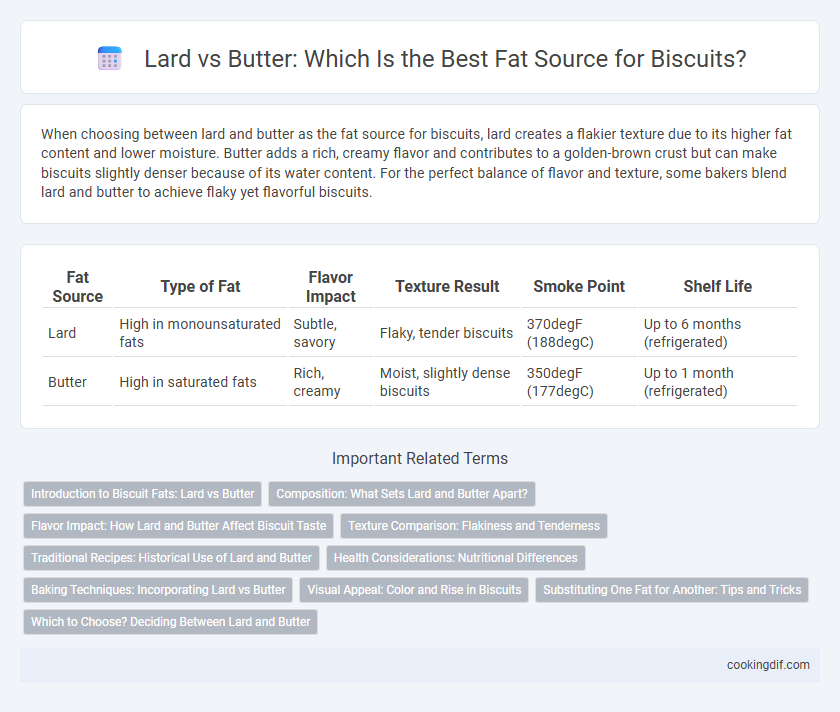When choosing between lard and butter as the fat source for biscuits, lard creates a flakier texture due to its higher fat content and lower moisture. Butter adds a rich, creamy flavor and contributes to a golden-brown crust but can make biscuits slightly denser because of its water content. For the perfect balance of flavor and texture, some bakers blend lard and butter to achieve flaky yet flavorful biscuits.
Table of Comparison
| Fat Source | Type of Fat | Flavor Impact | Texture Result | Smoke Point | Shelf Life |
|---|---|---|---|---|---|
| Lard | High in monounsaturated fats | Subtle, savory | Flaky, tender biscuits | 370degF (188degC) | Up to 6 months (refrigerated) |
| Butter | High in saturated fats | Rich, creamy | Moist, slightly dense biscuits | 350degF (177degC) | Up to 1 month (refrigerated) |
Introduction to Biscuit Fats: Lard vs Butter
Lard and butter are the primary fat sources used in biscuit making, each imparting distinct textures and flavors. Lard, rendered pork fat, produces exceptionally flaky and tender biscuits due to its larger fat crystals and higher melting point, while butter contributes rich flavor and a slightly denser crumb. Understanding the properties of lard versus butter helps bakers choose the ideal fat to achieve the desired biscuit quality and mouthfeel.
Composition: What Sets Lard and Butter Apart?
Lard consists primarily of monounsaturated fats, especially oleic acid, which contributes to its smooth texture and higher smoke point compared to butter. Butter contains a significant amount of saturated fats and water, alongside milk solids that influence its flavor and melting behavior. This distinct composition affects biscuit flakiness, with lard creating tender layers and butter adding a rich, creamy taste.
Flavor Impact: How Lard and Butter Affect Biscuit Taste
Lard imparts a flaky texture and a rich, savory flavor to biscuits, enhancing their traditional taste with subtle pork undertones. Butter provides a creamy, slightly sweet flavor that enriches the biscuit's aroma and adds a tender crumb. Choosing lard or butter as the fat source directly influences the biscuit's mouthfeel and overall flavor profile, with lard offering robustness and butter delivering a delicate, buttery sweetness.
Texture Comparison: Flakiness and Tenderness
Lard creates biscuits with exceptional flakiness due to its large fat crystals, which melt during baking and form distinct layers. Butter contributes a richer flavor and produces a tender crumb but typically results in slightly less flaky texture. Combining lard and butter can balance tenderness and flakiness, enhancing the overall biscuit quality.
Traditional Recipes: Historical Use of Lard and Butter
Traditional biscuit recipes often call for lard as the fat source due to its ability to create exceptionally flaky and tender textures, stemming from its higher fat content and unique crystalline structure. Butter, while also used historically, imparts a richer flavor and slightly denser crumb, favored in Southern American and European baking traditions. Historical culinary texts and regional variations highlight lard's dominance in early American biscuits before butter became more widely accessible through refrigeration and commercial production.
Health Considerations: Nutritional Differences
Butter contains higher levels of saturated fat and cholesterol compared to lard, potentially impacting cardiovascular health when consumed in excess. Lard offers a favorable balance of monounsaturated fats, including oleic acid, which may support heart health and reduce inflammation. Choosing between lard and butter as a fat source in biscuits depends on individual dietary needs and health goals, emphasizing moderation and quality.
Baking Techniques: Incorporating Lard vs Butter
Lard creates biscuits with a flakier texture due to its larger fat crystals that melt slowly during baking, forming distinct layers. Butter imparts a richer flavor and contributes moisture, but its lower melting point can result in less pronounced flakiness. Properly cutting lard or butter into flour while keeping ingredients cold is crucial to achieve tender, airy biscuits regardless of the fat used.
Visual Appeal: Color and Rise in Biscuits
Using lard as the fat source in biscuits yields a higher rise due to its superior shortening ability, creating a flaky, tender texture with a pale golden color. Butter provides a richer, deeper golden hue and a slightly denser crumb, enhancing visual appeal through its natural milk solids that caramelize during baking. Choosing lard results in light, airy biscuits, while butter delivers a visually warmer, more appetizing finish.
Substituting One Fat for Another: Tips and Tricks
Substituting lard for butter in biscuit recipes can enhance flakiness due to its higher fat content and lower water percentage, which creates steam layers that puff up during baking. When replacing butter with lard, reduce the overall fat quantity slightly since lard is 100% fat compared to butter's 80-82%, helping maintain proper dough consistency. For optimal results, chill the fat and dough thoroughly before baking to encourage flakiness and prevent excessive spreading.
Which to Choose? Deciding Between Lard and Butter
Choosing between lard and butter for biscuits depends on the desired texture and flavor profile; lard typically produces flakier, tender biscuits due to its higher fat content and unique fat composition. Butter offers a rich, creamy taste with a slightly firmer texture and adds a golden color from milk solids during baking. For optimal results, many bakers combine lard and butter to balance flakiness and flavor in biscuit recipes.
Lard vs Butter for fat source Infographic

 cookingdif.com
cookingdif.com